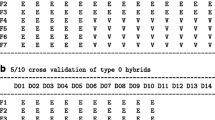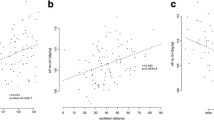Abstract
Grouping of germplasm and prediction of hybrid performance and heterosis are important applications in hybrid breeding programs. Gene expression analysis is a promising tool to achieve both tasks efficiently. Our objectives were to (1) investigate distance measures based on transcription profiles, (2) compare these with genetic distances based on AFLP markers, and (3) assess the suitability of transcriptome-based distances for grouping of germplasm and prediction of hybrid performance and heterosis in maize. We analyzed transcription profiles from seedlings of the 21 parental maize lines of a 7 × 14 factorial with a 46-k oligonucleotide array. The hybrid performance and heterosis of the 98 hybrids were assessed in field trials. In cluster and principal coordinate analyses for germplasm grouping, the transcriptome-based distances were as powerful as the genetic distances for separating flint from dent inbreds. Cross validation showed that prediction of hybrid performance with transcriptome-based distances using selected markers was more precise than earlier prediction models using DNA markers or general combining ability estimates using field data. Our results suggest that transcriptome-based prediction of hybrid performance and heterosis has a great potential to improve the efficiency of maize hybrid breeding programs.






Similar content being viewed by others
References
Birchler JA, Auger DL, Riddle NC (2003) In search of the molecular basis of Heterosis. Plant Cell 15:2236–2239
Boppenmeier J, Melchinger AE, Brunklaus-Jung E, Geiger HH, Herrmann RG (1992) Genetic diversity for RFLPs in European maize inbreds. I: relation to performance of Flint x Dent crosses for forage traits. Crop Sci 32:895–902
Charcosset A, Essioux L (1994) The effect of population-structure on the relationship between heterosis and heterozygosity at marker loci. Theor Appl Genet 89:336–343
Guo M, Rupe M, Yang X, Crasta O, Zinselmeier C, Smith O, Bowen B (2006) Genome-wide transcript analysis of maize hybrids: allelic additive gene expression and yield heterosis. Theor Appl Genet 113:831–845
Ihaka R, Gentleman R (1996) R: A language for data analysis and graphics. J Comput Graph Stat 5:299–314
Kendziorski C, Irizarry RA, Chen K-S, Haag JD, Gould MN (2005) On the utility of pooling biological samples in microarray experiments. Proc Nat Acad Sci 102:4252–4257
Kerr MK, Churchill GA (2001) Statistical design and the analysis of gene expression microarray data. Genet Res 77:123–128
Maenhout S, De Baets B, Haesaert G (2009) Prediction of maize single-cross hybrid performance: support vector machine regression versus best linear prediction. Theor Appl Genet (in press)
Melchinger AE (1999) Genetic diversity and heterosis. In: Coors JG, Pandey S (eds) The genetics and exploitation of heterosis in crops. ASA-CSSA, Madison, pp 99–118
Reif JC, Melchinger AE, Frisch M (2005) Genetical and mathematical properties of similarity and dissimilarity coefficients applied in plant breeding and seed bank management. Crop Sci 45:1–7
Reif JC, Melchinger AE, Xia XC, Warburton ML, Hoisington DA, Vasal SK, Srinivasan G, Bohn M, Frisch M (2003) Genetic distance based on simple sequence repeats and heterosis in tropical maize populations. Crop Sci 43:1275–1282
Repsilber D, Andorf S, Selbig J, Altmann T, Witucka-Wall H (2009) Enriched partial correlations in genome-wide gene expression profiles of hybrids (A. thaliana)—a systems biological approach towards the molecular basis of heterosis. Theor Appl Genet (in press)
Schrag TA, Melchinger AE, Sorensen AP, Frisch M (2006) Prediction of single-cross hybrid performance for grain yield and grain dry matter content in maize using AFLP markers associated with QTL. Theor Appl Genet 113:1037–1047
Schrag TA, Maurer HP, Melchinger AE, Piepho HP, Peleman J, Frisch M (2007) Prediction of single-cross hybrid performance in maize using haplotype blocks associated with QTL for grain yield. Theor Appl Genet 114:1345–1355
Schrag TA, Möhring J, Maurer HP, Dhillon BS, Melchinger AE, Piepho HP, Sorensen AP, Frisch M (2009a) Molecular marker-based prediction of hybrid performance in maize using unbalanced data from multiple experiments with factorial crosses. Theor Appl Genet 118:741–751
Schrag TA, Möhring J, Kusterer B, Dhillon BS, Melchinger AE, Piepho HP, Frisch M (2009b) Hybrid performance prediction in maize using molecular markers and joint analyses of hybrids and parental inbreds. Theor Appl Genet (in press)
Springer NM, Stupar RM (2007) Allelic variation and heterosis in maize: How do two halves make more than a whole? Genome Res 17:264–275
Steinfath M, Gärtner T, Lisec J, Meyer RC, Altmann T, Willmitzer L, Selbig J (2009) Prediction of hybrid biomass in Arabidopsis thaliana by selected parental SNP and metabolic markers. Theor Appl Genet (in press)
Stupar RM, Gardiner JM, Oldre AG, Haun WJ, Chandler VL, Springer NM (2008) Gene expression analyses in maize inbreds and hybrids with varying levels of heterosis. BMC Plant Biol 8:33
Thiemann A, Fu J, Schrag TA, Melchinger AE, Frisch M, Scholten S (2009) Correlation between parental transcriptome and field data for the characterization of heterosis in Zea mays L. Theor Appl Genet (in press)
Vuylsteke M, Kuiper M, Stam P (2000) Chromosomal regions involved in hybrid performance and heterosis: their AFLP-based identification and practical use in prediction models. Heredity 85:208–218
Acknowledgments
This research was funded by the Deutsche Forschungsgemeinschaft (DFG, German Research Foundation) within the priority program SPP 1149 “Heterosis in Plants” (grant no. FR 1615/4-1). We thank Prof. Dr. B.S. Dhillon for helpful suggestions on our manuscript. This article is dedicated to Professor Dr. H. Friedrich Utz on the occasion of his 70th anniversary.
Author information
Authors and Affiliations
Corresponding author
Additional information
Communicated by A. Charcosset.
Contribution to the special issue "Heterosis in Plants".
Rights and permissions
About this article
Cite this article
Frisch, M., Thiemann, A., Fu, J. et al. Transcriptome-based distance measures for grouping of germplasm and prediction of hybrid performance in maize. Theor Appl Genet 120, 441–450 (2010). https://doi.org/10.1007/s00122-009-1204-1
Received:
Accepted:
Published:
Issue Date:
DOI: https://doi.org/10.1007/s00122-009-1204-1




